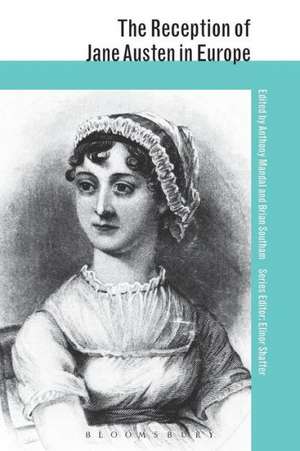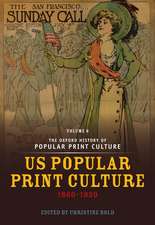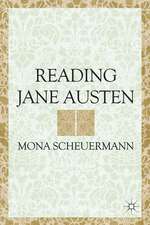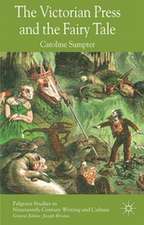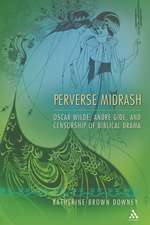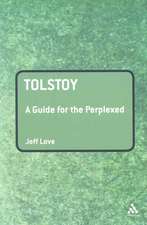The Reception of Jane Austen in Europe: The Reception of British and Irish Authors in Europe
Editat de Dr Anthony Mandal, Brian Southamen Limba Engleză Paperback – 9 apr 2014
| Toate formatele și edițiile | Preț | Express |
|---|---|---|
| Paperback (1) | 192.42 lei 6-8 săpt. | |
| Bloomsbury Publishing – 9 apr 2014 | 192.42 lei 6-8 săpt. | |
| Hardback (1) | 1882.05 lei 6-8 săpt. | |
| Bloomsbury Publishing – 12 aug 2007 | 1882.05 lei 6-8 săpt. |
Din seria The Reception of British and Irish Authors in Europe
- 44%
 Preț: 2166.85 lei
Preț: 2166.85 lei -
 Preț: 189.28 lei
Preț: 189.28 lei -
 Preț: 192.15 lei
Preț: 192.15 lei -
 Preț: 188.34 lei
Preț: 188.34 lei - 34%
 Preț: 229.75 lei
Preț: 229.75 lei -
 Preț: 193.96 lei
Preț: 193.96 lei -
 Preț: 398.19 lei
Preț: 398.19 lei -
 Preț: 192.99 lei
Preț: 192.99 lei -
 Preț: 190.44 lei
Preț: 190.44 lei - 34%
 Preț: 230.90 lei
Preț: 230.90 lei -
 Preț: 586.90 lei
Preț: 586.90 lei -
 Preț: 190.81 lei
Preț: 190.81 lei - 36%
 Preț: 192.15 lei
Preț: 192.15 lei - 36%
 Preț: 192.42 lei
Preț: 192.42 lei - 44%
 Preț: 1667.84 lei
Preț: 1667.84 lei - 44%
 Preț: 1317.79 lei
Preț: 1317.79 lei - 44%
 Preț: 1317.79 lei
Preț: 1317.79 lei - 44%
 Preț: 1433.99 lei
Preț: 1433.99 lei - 35%
 Preț: 193.18 lei
Preț: 193.18 lei -
 Preț: 192.15 lei
Preț: 192.15 lei -
 Preț: 229.37 lei
Preț: 229.37 lei - 17%
 Preț: 329.44 lei
Preț: 329.44 lei -
 Preț: 1893.83 lei
Preț: 1893.83 lei -
 Preț: 1667.84 lei
Preț: 1667.84 lei - 14%
 Preț: 1471.24 lei
Preț: 1471.24 lei - 36%
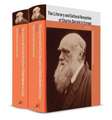 Preț: 1783.83 lei
Preț: 1783.83 lei
Preț: 192.42 lei
Preț vechi: 298.45 lei
-36% Nou
Puncte Express: 289
Preț estimativ în valută:
36.82€ • 38.55$ • 30.54£
36.82€ • 38.55$ • 30.54£
Carte tipărită la comandă
Livrare economică 09-23 aprilie
Preluare comenzi: 021 569.72.76
Specificații
ISBN-13: 9781472535917
ISBN-10: 147253591X
Pagini: 464
Dimensiuni: 156 x 234 x 24 mm
Greutate: 0.65 kg
Editura: Bloomsbury Publishing
Colecția Bloomsbury Academic
Seria The Reception of British and Irish Authors in Europe
Locul publicării:London, United Kingdom
ISBN-10: 147253591X
Pagini: 464
Dimensiuni: 156 x 234 x 24 mm
Greutate: 0.65 kg
Editura: Bloomsbury Publishing
Colecția Bloomsbury Academic
Seria The Reception of British and Irish Authors in Europe
Locul publicării:London, United Kingdom
Caracteristici
* This volume covers Austen's reception across Europe and her influence on European literature and culture
Notă biografică
Anthony Mandal is Reader in English Literature and Director of the Centre for Editorial and Intertextual Research at Cardiff University. His publications include Jane Austen and the Popular Novel: The Determined Author (2007) and a new scholarly edition of Mary Brunton's bestselling Regency novel, Self-Control (2014). He is also one of the General Editors of the New Edinburgh Edition of the Works of Robert Louis Stevenson.Brian Southam was an active figure in Austen studies, in which he played a formative role, until his death in 2010. Among his many books are Jane Austen's Literary Manuscripts(1964, 1966, 2001), two volumes of Jane Austen: The Critical Heritage, 1811-1940 (1968, 1987) and Jane Austen and the Navy (2000, 2005).Elinor Shaffer, FBA, is Senior Research Fellow, Institute of Modern Languages Research, School of Advanced Study, University of London, and Director of the Research Project on the Reception of British and Irish Authors in Europe. The author of The Fall of Jerusalem: The Mythological School in Biblical Criticism and Secular Literature 1770-1880(Cambridge University Press), and Erewhons of the Eye: Samuel Butler as Painter, Photographer, and Art Critic (Reaktion), and many articles on Coleridge's aesthetics and other topics in European Romantic studies, she was a founder member of the British Comparative Literature Association and editor of the annual journal Comparative Criticism(Cambridge), and has taught in universities in Britain, the United States and Europe.
Cuprins
Series Editor's Preface: Elinor Shaffer (University of London)AcknowledgementsList of ContributorsAbbreviationsTimeline: European Reception of Jane Austen: Anthony Mandal (Cardiff University) and Paul Barnaby Introduction: Anthony Mandal (Cardiff University)1. The Reception of Jane Austen's Novels in France and Switzerland: The Early Years, 1813-1828: Isabelle Bour (University of Tours)2. The Reception of Jane Austen in France: The Later Nineteenth Century, 1830-1900: Isabelle Bour (University of Tours)3. The Reception of Jane Austen in France in the Modern Period, 1901-2004: Recognition at Last?: Isabelle Bour (University of Tours)4. Going Dutch: The Reception of Jane Austen in the Low Countries: Maximiliaan van Woudenberg (Sheridan Institute of Technology)5. The Reception of Jane Austen in Germany: Annika Bautz (University of Keele)6. 'Unconditional Surrender'? Jane Austen's Reception in Denmark: Peter Mortensen (Aarhus University)7. Jane Austen and Norway: Sharing the Long Road to Recognition: Marie Nedregotten Sørbø (Volda University College) 8. Jane Austen's Reception in Sweden: Irony as Criticism and Literary Value: Git Claesson Pipping (Södertörn University College) and Eleanor Wikborg (Stockholm University )9. The Reception of Jane Austen in Finland: Ellen Valle (University of Turku)10. Still the Great Forgotten? The Reception of Jane Austen in Spain: Aída Díaz Bild (University of La Laguna)11. The Reception of Jane Austen in Italy: Beatrice Battaglia (University of Bologna)12. The Reception of Jane Austen in Greece: Katerina Kitsi-Mitakou (Aristotle University, Thessaloniki) and Maria Vara (Aristotle University, Thessaloniki)13. Jane Austen in Hungary: Nóra Séllei (University of Debrecen)14. A Hidden but Prestigious Voice: Jane Austen's Fiction in Slovenia: Vanesa Matajc (University of Ljubljana)15. Between Bath and Bosnia: Jane Austen and Croatian Culture: Tatjana Jukic (University of Zagreb)16. Jane Austen in Serbia, 1929--2000: Svetozar Koljevic(University of Sarajevo)17. Jane Austen: Persuading Romanian Readerships and Audiences: Mihaela Mudure (Babes-Bolyai University)18. The Reception of Jane Austen in Poland: Grazyna Bystydzienska (University of Warsaw)19. The Reception of Jane Austen in Russia: Catharine Nepomnyashchy (Columbia University)BibliographyIndex
Recenzii
In the age of 'global' Jane Austen...the study of her reception around the world and through the ages is becoming of increasing interest to her readers. For this reason this collection of essays...is extremely timely...Each contribution stands on its own, enabling readers to delve into the history of Austen's increasing popularity in a particular country, while the exhaustive timeline, which charts the pan-European reception of Austen from 1775 to the present day (a stroke of genius), and the introduction by Professor Mandal provide the all-important overview of the vast subject matter of the book. As we approach the two hundredth anniversary of the foreign reception of Austen's peerless novels, we are fortunate to be able to welcome this fine new contribution to the important tradition of scholarship that explores and assesses the amazing phenomenon of Austen's enduring legacy and universal fame.
As an empirical piece of research, this edition is faultless; however, its chief value lies in the stories it tells of British-European relations in the nineteenth and twentieth centuries, and of the new ground it opens up in terms of widening Austne scholarship.The Reception of Jane Austen in Europe proves again how complex this apparently straightforward writer is; it is not so much the case that Austen can or cannot 'travel'; simply that she has rarely made the journey untarnished. But the journeys have been many, and whether Austen was translated in her lifetime (France), or not until the 1960s (Russia), there is a story to be told.
This substantial volume, in the editors' words, builds on 'earlier commentaries by providing, for the first time, a comprehensive account of Austen's reception across seventeen nations' (2007, 2).
The detailed scholarship in The Reception of Jane Austen in Europe makes this an impressive reference volume, with plenty of translation interest.
As an empirical piece of research, this edition is faultless; however, its chief value lies in the stories it tells of British-European relations in the nineteenth and twentieth centuries, and of the new ground it opens up in terms of widening Austne scholarship.The Reception of Jane Austen in Europe proves again how complex this apparently straightforward writer is; it is not so much the case that Austen can or cannot 'travel'; simply that she has rarely made the journey untarnished. But the journeys have been many, and whether Austen was translated in her lifetime (France), or not until the 1960s (Russia), there is a story to be told.
This substantial volume, in the editors' words, builds on 'earlier commentaries by providing, for the first time, a comprehensive account of Austen's reception across seventeen nations' (2007, 2).
The detailed scholarship in The Reception of Jane Austen in Europe makes this an impressive reference volume, with plenty of translation interest.
